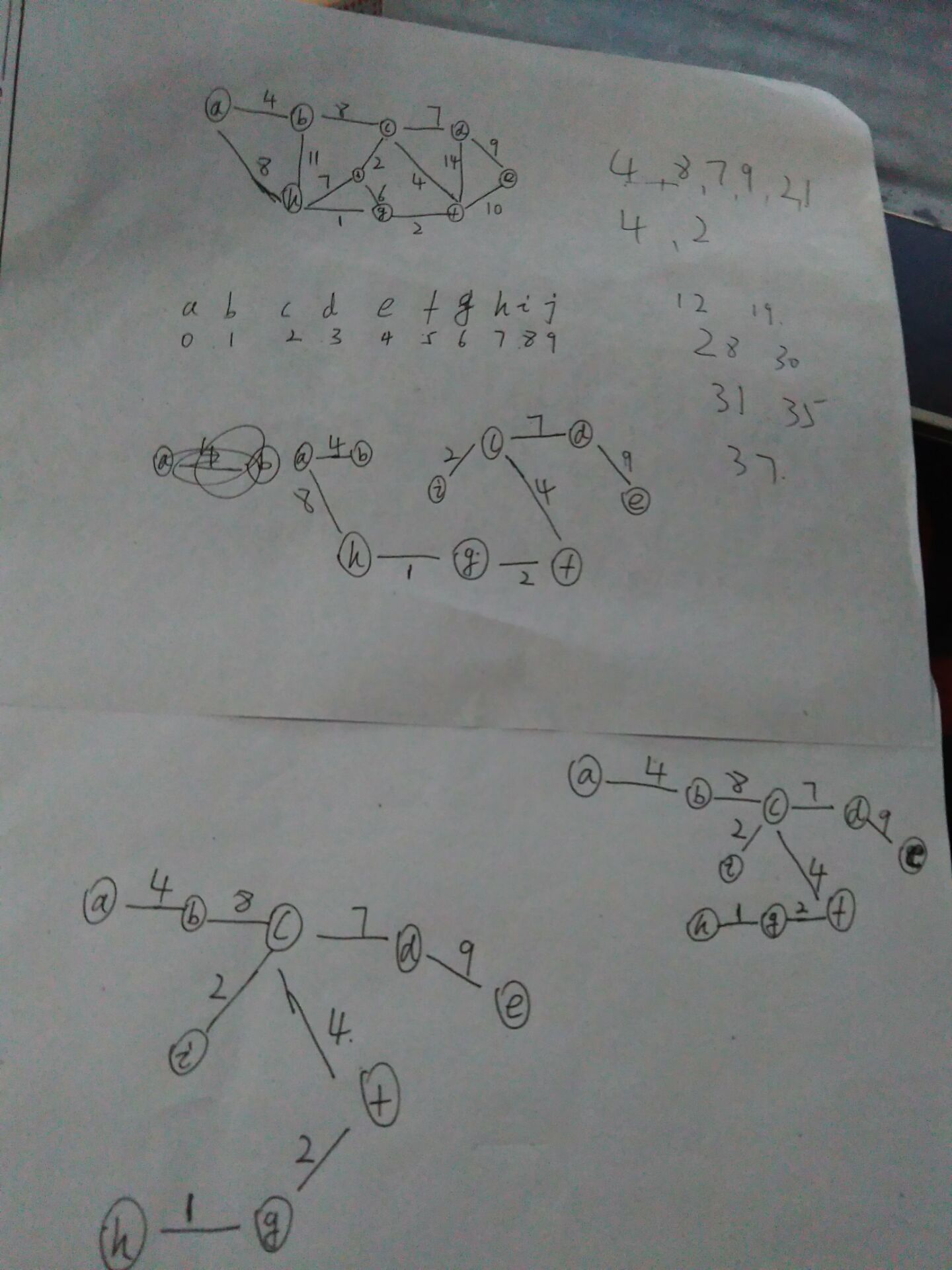kruskal算法,没有进行算法复杂度分析
判断俩个结点是否在同一个树上使用了dfs,比较low的写法
输入数据
//第一行,结点数,结点数,边数
9 9 14
a b 4
b c 8
c d 7
a h 8
b h 11
h i 7
i c 2
i g 6
c f 4
d f 14
d e 9
f e 10
g h 1
g f 2
//============================================================================
// Name : kruskal.cpp
// Author : caicai
// Version :
//============================================================================
#include <iostream>
#include <stdio.h>
#include <memory.h>
using namespace std;
struct Node
{
char s;
char e;
int w;
};
void printMap(int r, int a[][100])
{
for(int i = 0; i < r; i++)
{
for(int j = 0; j < r; j++)
{
printf("%-3d", a[i][j]);
}
cout << endl;
}
cout << endl;
}
/**
* 边根据权重从小到大排序
*/
void sortEdge(Node edges[], int total)
{
Node temp;
for(int i = 0; i < total; i++)
{
for(int j = 1; j < total; j++)
{
if(edges[j - 1].w > edges[j].w)
{
temp = edges[j - 1];
edges[j - 1] = edges[j];
edges[j] = temp;
}
}
}
}
void printEdges(Node edges[], int total)
{
for(int i = 0; i < total; i++)
cout << edges[i].s << " " << edges[i].e << " " << edges[i].w << endl;
}
void dfs(int a[][100], int r, int s, int e, int* ok, int vis[])
{
for(int i = 0; i < r; i++)
{
if(vis[i] || a[s][i] == 0)
{
//走过,不存在的路
continue;
}
if(i == e)
{
//可到
*ok = 0;
return;
}
vis[i] = 1;
//从当前结点出发,不需要回溯,如果当前结点到不了,从其他结点到当前结点同样是到不了
dfs(a, r, i, e, ok, vis);
}
}
void kruskal(int a[][100], int r, Node edges[], int et)
{
/**
* 图G n个结点,刚开始每一个结点都一个单独的结点,并没有与任何结点连接
* 将边按照权值从小到大排序
* 循环边集合,检查该边连接的俩个点,是否在同一个树上,如果是,不要,如果不是,加入到最小生成树中
* 怎么检查,a到b是否有一个条路
* 检查是否在同一个树中,dfs检查
*/
/*
*1初始化:生成的树为空,总权值为0
*2循环:每一次循环边,加入到数组a,数组a中包含n棵树,对于每一颗树,加入的边的权值最小,所以加入此边后形成的树的总权也是最小的
* 当俩棵树合并时,每棵的树的总权值也是最小的,所以相加后总权也是最小
*3终止:每一次加入的边是权值也是最小的,所以循环终止时,总权也是最小的
*/
for(int i = 0; i < et; i++)
{
char s = edges[i].s;
char e = edges[i].e;
int ok = 1;
int vis[100];
memset(vis, 0, sizeof(vis));
//检查耗时
dfs(a, r, s - 'a', e - 'a', &ok, vis);
if(ok)
{
//不在同一颗树中,当前的边加入到树中
a[s - 'a'][e - 'a'] = edges[i].w;
//无向图
a[e - 'a'][s - 'a'] = edges[i].w;
}
}
}
int main()
{
freopen("d:\2.txt", "r", stdin);
int r;
int te;
cin >> r >> r >> te;
char s, e;
int w;
int a[100][100];
Node edges[100];
int et = 0;
while (te--)
{
cin >> s >> e >> w;
//cout << s << " " << e << " " << w << endl;
Node node;
node.s = s;
node.e = e;
node.w = w;
edges[et++] = node;
}
sortEdge(edges, et);
printEdges(edges, et);
kruskal(a, r, edges, et);
printMap(r, a);
return 0;
}
输出
g h 1 i c 2 g f 2 a b 4 c f 4 i g 6 c d 7 h i 7 b c 8 a h 8 d e 9 f e 10 b h 11 d f 14 0 4 0 0 0 0 0 0 0 4 0 8 0 0 0 0 0 0 0 8 0 7 0 4 0 0 2 0 0 7 0 9 0 0 0 0 0 0 0 9 0 0 0 0 0 0 0 4 0 0 0 2 0 0 0 0 0 0 0 2 0 1 0 0 0 0 0 0 0 1 0 0 0 0 2 0 0 0 0 0 0
